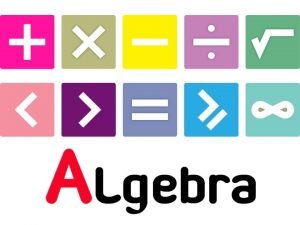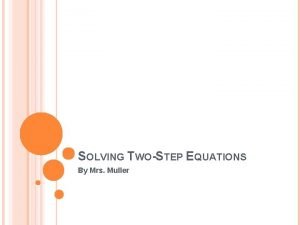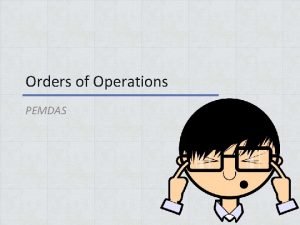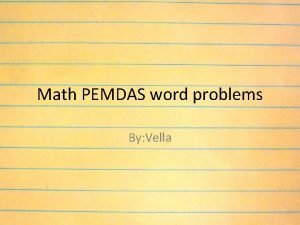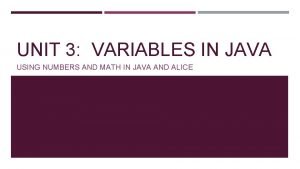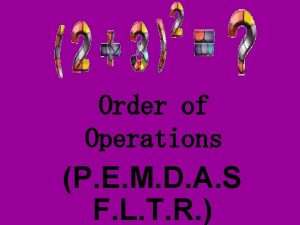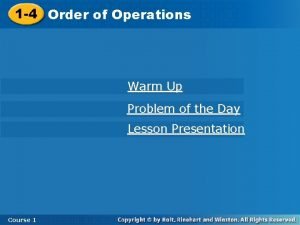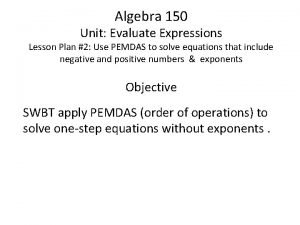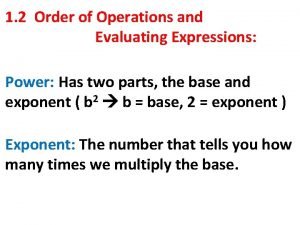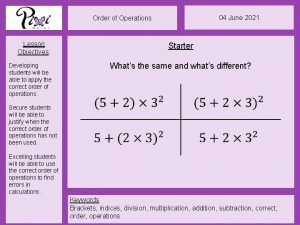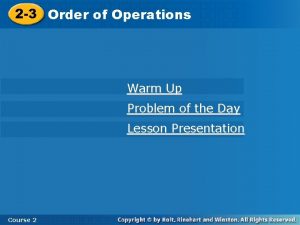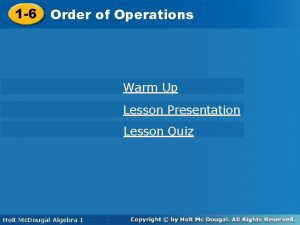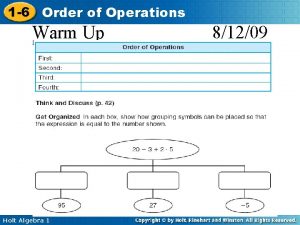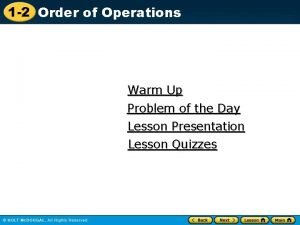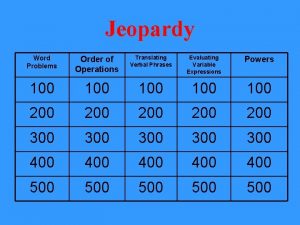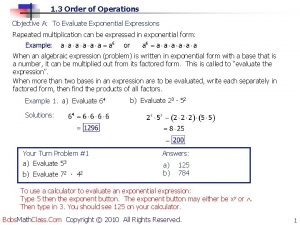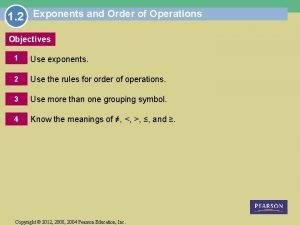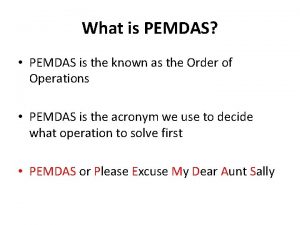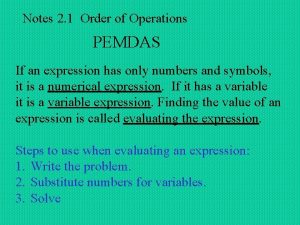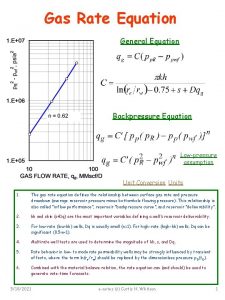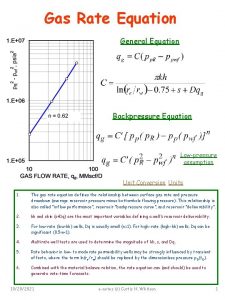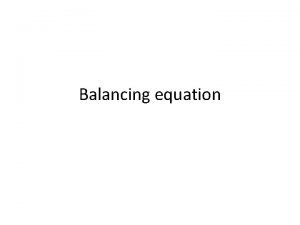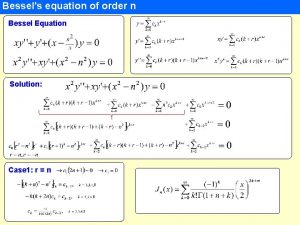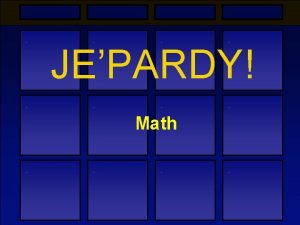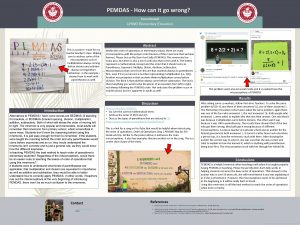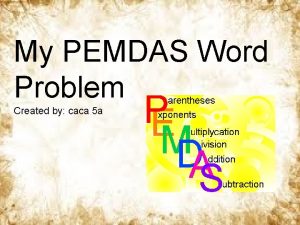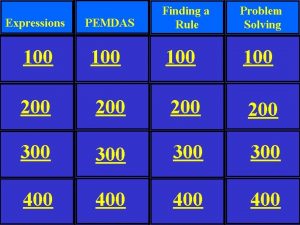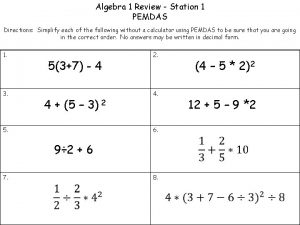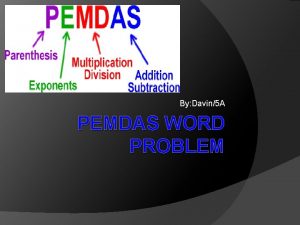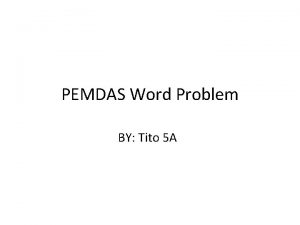Equation The Order of Operations PEMDAS The order










































- Slides: 42


Equation

The Order of Operations (PEMDAS) The order in which you perform the mathematical functions should primarily be determined by the functions themselves. In the correct order, the six operations are Parentheses, Exponents Multiplication/Division, and Addition/Subtraction(or PEMDAS). PEMDAS is a useful acronym you can use to remember the order in which operations should be performed.

The Order of Operations (PEMDAS) The correct order of steps to simplify this sample expression is as follows: Parentheses Exponents Multiplication or Division (left to right) Addition or Subtraction (left to right)

Solving for a Variable with One Equation Solving Equation A solution to an equation is a number that, when substituted in for the value of a variable, makes the equation true. Now that you know the best way to isolate a variable, you did PEMDAS backwards! Start with addition/subtraction, then multiplication/division, then exponents, and finish with terms in parentheses.

Example : A/S M/D E P

Equation Clean-up Moves • You can do whatever you want to one side of the equation, as long as you do the same thing to the other side at the same time • To isolate a variable, you should perform the PEMDAS operations in revers order: 1. Addition/Subtraction 2. Multiplication/Division 3. Exponents/Roots 4. Parentheses • To clean up an equation: 1. Get variables out of denominators by multiplying both sides by that entire denominator. 2. Simplify grouped terms by multiplying or distributing. 3. Combine similar or like terms.

Solving for a Variable with Two Equation Substitution One method for combining equations is called substitution. In substitution, you insert the expression for one variable in one equation into that variable in the other equation. There are four basic steps to substitution, which can be demonstrated with the question from above. Step one is to isolate one of the variables in one of the equations. For this example, y is already isolated in the second equation: y = x – 2. Step Two, it is important to understand that the left and right sides of the equation are equivalent. Step Two will be to the first equation, and substitute )hence the name (the variable y with its equivalent, )x - 2. (So: 3 x + y = 10 3 x + (x – 2) = 10

Solving for a Variable with Two Equation Substitution Step Three, you have one equation and one variable, so the next step is to solve for x: 3 x + x – 2 = 10 x = 3 Now that you have a value for x, Step Four is to substitute that value into either original equation to solve for your second variable, y: y = x -2 y = (3) – 2 = 1 So the answer to the question is y = 1. It should be noted that Step Four will only be necessary if the variable you solve for in Step Three is not the variable the question asks for. The question asked for y, but you found x, so Step Four was needed to answer the question.

Subtraction of Expressions One of the most common error involving order of operations occurs when an expression with multiple terms is subtracted. The subtraction must occur across every term within the expression. Each term in the subtracted part must have its sign reversed. Here are several examples: x – (y - z) = x – y + z (Note that the signs of both y and -z have been reversed. ) x – (y + z) = x - y – z (Note that the signs of both y and z have been reversed. ) x – 2(y - 3 z) = x - 2 y + 6 z (Note that the signs of both y and -3 z have been reversed. )

Quadratic Equation

Distributing Simplifying this expression is really an extension of the principle of distributionevery term in the first part of the expression must multiply every term in the second part of the expression. In order to do so correctly every time, you can use a handy acronym to remember the steps necessary : FOIL. The letters stand for First, Outer, Inner, Last.

In this case, it looks like this: )a + b)(x + y( F – multiply the first term in each of the parentheses: a ×y = ax. O – Multiply the outer term in each: a × y = ay. I – Multiply the inner term in each: b × x = bx. L – Multiply the last term in each: b × y = by. So you have )a + b)(x + y( = ax + ay + bx + by.

Factoring You can factor out many different things on the GRE: variables, variables with exponents, numbers, and expressions with more than one term, such as (y - 2) or (x + w). Here are some examples: Factor out a t. Notice that a 1 remains behind when you factor a t out of a t. Factor out a 7; since the variables are different, you can’t factor out any variables.

Factoring Quadratic Equations F O + I L + 6 The 2 and the 3 play two important roles in building the quadratic expression: • They multiply together to give you 6, which is the final term in your quadratic expression. • Multiplying the outer terms gives you 3 x, and multiplying the inner terms gives you 2 x. You can then add those terms to get 5 x, the middle term of your quadratic expression.

6 2 x 3 2+3 5

6 2 x 3 2+3 5 So the diamond puzzle is just a visual representation of this same goal. For any Quadratic expression, take the final term (the constant) and place it in the top portion of the diamond. Take the coefficient of the middle term (in this case, the “ 5” in “ 5 x”) and place it in the lower portion of the diamond. For instance, if the middle term is 5 x, take the 5 and place it at the bottom of the diamond.

Solving Quadratic Equations Now that you know how to factor quadratic, it’s time to make that final jump to actually solving equations. When first discussing, it was noted that when one side of the equation is equal to 0, you can make use of the rule that anything times 0 is 0. In the case of the equation (x - 5)(x + 10) = 0, you know that either (x - 5) = 0 or (x + 10) = 0, which means that x = 5 or x = - 10.

The Three Special Products

Inequalities & Absolute value

Inequalities

Solving Inequalities

Inequality Addition and Subtraction

Inequality Multiplication and Division If you multiplying or dividing by a positive number — the sign stay the same If you multiplying or dividing by a negative number — switch the sign !

Absolute Value — Distance on the Number Line The absolute value of a number describes how far that number is away from 0. Example 1 : The absolute value of 5 is 5 : Distance = 5 Example 2 : The absolute value of -5 is 5 : Distance = 5

Solving Absolute Value equation

Inequalities and Absolute Values



Manipulating Compound Inequalities Perform operation on a compound inequality as long as you remember to perform those operation on every term in the inequality. For example Wrong: You must subtract 3 from every term in the inequality. Correct

Extreme Values This is particularly helpful when solving the following types of inequality problems 1. Problem with multiple inequalities where the question involves the potential range of values for variables in the problem. 2. Problems involving both equations and inequalities. • Optimization Problem In these minimization and maximization problems, you need to focus on the largest and smallest possible values for each of the variables.

Formulas & Function

Strange Symbol Formulas

Formulas with Unspecified Amounts

Sequence Formulas

Sequence Problems -Determine which answer choice corresponds to the correct definition (or rule) for a sequence (direct or recursive). -Determine the value of a particular item in a sequence -Determine the sum or difference of a set of items in a sequence.

Sequence and Patterns

Functions

Numerical Substitution Variable Substitution

Compound Functions

Function Graphs A function can be visualized by graphing it in the coordinate plane. The input variable is considered the domain of the function, or the x-coordinate. The corresponding output is considered the range of the function, or the y-coordinate

By… Aknarin Watchakorn Pasit Lamsan Chandang Chucherd 56131111061 56131111069 56131111075
 Pemdas math
Pemdas math Pemdas shuffle
Pemdas shuffle Reverse pemdas
Reverse pemdas Funny ways to remember pemdas
Funny ways to remember pemdas Pemdas rule
Pemdas rule Pemdas please excuse
Pemdas please excuse Order of operations word problems
Order of operations word problems Order of operations facts
Order of operations facts Does java follow pemdas
Does java follow pemdas Pmdas word problem
Pmdas word problem Pemdas meaning
Pemdas meaning Order of operations review
Order of operations review What is a pemda
What is a pemda Order of operations warm up
Order of operations warm up Pemdas with decimals
Pemdas with decimals 1st order 2nd order 3rd order neurons
1st order 2nd order 3rd order neurons Forecasting in operations management
Forecasting in operations management Order of operations with powers
Order of operations with powers Greatest to least fraction
Greatest to least fraction Objectives for order of operations
Objectives for order of operations Opord sustainment paragraph
Opord sustainment paragraph Excel vocabulary
Excel vocabulary Order of operations lesson plan
Order of operations lesson plan 5 paragraph order
5 paragraph order Jeopardy multiplication and division
Jeopardy multiplication and division Order of operations and evaluating expressions
Order of operations and evaluating expressions Job order cost system vs process cost system
Job order cost system vs process cost system What is the correct order of operations
What is the correct order of operations 1-2 skills practice order of operations
1-2 skills practice order of operations Order of operations learning objectives
Order of operations learning objectives Order of operations jeopardy
Order of operations jeopardy Order of operations bell ringer
Order of operations bell ringer Order of operations warm up
Order of operations warm up Order of operations warm up
Order of operations warm up Order of operations warm up
Order of operations warm up Order of operations warm up
Order of operations warm up Order of operations jeopardy
Order of operations jeopardy Bobsmathclass
Bobsmathclass Order of operations objectives
Order of operations objectives Hát kết hợp bộ gõ cơ thể
Hát kết hợp bộ gõ cơ thể Bổ thể
Bổ thể Tỉ lệ cơ thể trẻ em
Tỉ lệ cơ thể trẻ em
